
We don’t like reminding ourselves that living in one of the world’s most locked-down cities – ahem, Melbourne – during a once-in-a-century health crisis denies you a few things.
First, it was the 2020 Australian F1 Grand Prix. Then an AFL final. Soon, it quickly dawned on us a while would pass before we’d see big competition in the flesh again. So, you can imagine the collective groan heard around the Wheels office when we had to cancel the first mid-size SUV mega-test organised in a while.
With the Hyundai Tucson landing fresh from a generational makeover in April, we finally had a showdown sorted until our entries from Toyota, Subaru and Mazda were forced to pull out. Thankfully, we didn’t have to send home the plucky new Hyundai Tucson. We’ve been meaning to throw the Honda CR-V and Skoda Karoq that did show up into a scrap since they underwent light refreshes in 2020. Taking on a category favourite would also offer them a chance to re-establish their talents.
UPDATE, May 26 2022: The Karoq has had a styling update for 2022, which you can read about at the linke below. The rest of this story remains unchanged, but our latest reviews are also linked below.

Of course, it helps that our three share more than just white paint jobs and the same market segment. They come to us sans options and either as the base variant in their respective model ranges or one rung above, ensuring that – on RRP – they’re priced within hundreds of dollars to each other in the under-$35K bracket. On top of this, and because of their range positioning, the trio is also closely aligned on powertrain layout. Each variant houses a petrol inline four-cylinder engine placed latitudinally, supplying drive to the front wheels through an automatic transmission.
But it’s also interesting where our $35K front-drive contenders diverge. The Hyundai Tucson, for instance, is the newest of the three after launching internationally in late 2020 as an all-new fourth generation. After five months on sale to the end of September, it’s already made an impact on buyers, taking the medium-SUV category’s fifth spot with an 8.5 percent share of sales.
Our tester shares its atmo 2.0-litre, six-speed automatic powertrain with the Elite featured in Wheels’ long-termer Garage but strips the equipment list to its most basic form. Simply named ‘Tucson’ as a variant, it kicks off entry into the model range at $34,500, which raises the base price by almost $5K above the previous generation.
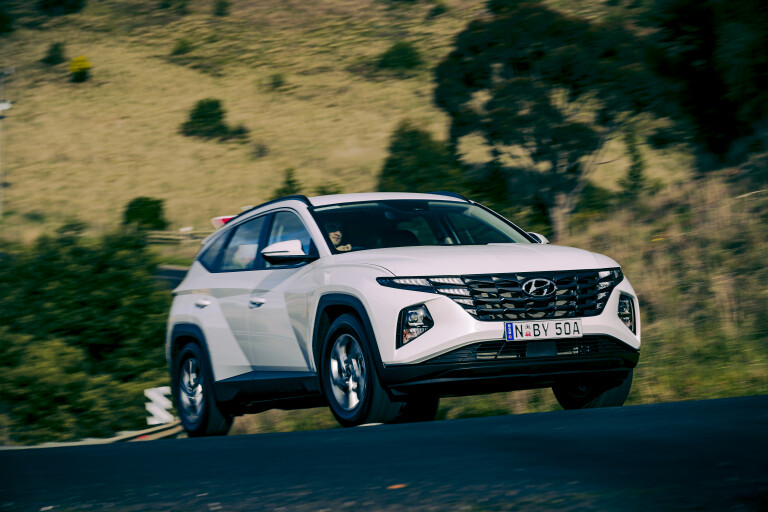
That money buys our Tucson Hyundai’s SmartSense active-safety suite with blind-spot collision avoidance, lane-keeping and following assist, active cruise control, broad-scenario AEB and a rear-view camera with guidelines. It also scores wireless smartphone mirroring, an 8.0-inch touchscreen, wireless phone charging, a pair of USB ports front and rear, six-speaker audio, leather gear lever and steering wheel and power folding mirrors.
Our second contender, the Honda CR-V, is a generation older than the Tucson. But age hasn’t been kind to sales for the Thai-built SUV. Available as both a five- or seven-seater since its arrival in 2017, the CR-V has lost grip on top-five market share, accounting this year for only 4.3 percent of category sales until the end of September. That’s not for a lack of choice. The base Vi grade is the first of seven and would have suited this match-up nicely if Honda could have supplied a Vi for the test. Instead, our CR-V comes one grade higher in VTi trim and with five seats.
That still suits, however, with the VTi falling almost line ball with the Tucson on price, if you ignore Honda’s recent move away from RRP to a nationwide driveaway pricing structure, officially setting the VTi at $38,300 driveaway. It was set at $34,200 RRP until August – or only $300 shy of the Tucson. Either way, a VTi ups the ante on a Vi by replacing its 2.0-litre atmo engine with a 1.5-litre turbocharged unit, still mated with a continuously variable transmission. And after a range refresh in late 2020, it also welcomed upgraded equipment.

Part of that includes a 7.0-inch central touchscreen, smartphone mirroring, adaptive cruise control, as well as AEB and lane-keep assist that were missing before. The VTi also has two pairs of USB ports, keyless start, rear vents, digital instrument cluster, rear camera with guidelines and power folding mirrors. And while it boasts dual-zone climate control and eight-speaker audio over the Tucson, stuff like a leather wheel, wireless phone charger and blind-spot warning or rear cross-traffic collision avoidance are absent.
Our next variant garnishes our comparison with a European flavour, of the goulash kind. The Czechia-built Skoda Karoq replaced the Yeti in Australia halfway through 2018. Since then, it’s humbly grown its presence in the category to claim 1.1 percent of sales so far in 2021. Welcoming a range-topping Sportline 4x4 variant helped broaden the range’s appeal, but Skoda’s decision to completely replace the powertrain in the automatic 110TSI Style was more pragmatic.
Halfway through 2020, when the Sportline arrived, Skoda swapped in a 1.4-litre petrol turbo with an Aisin-built eight-speed automatic to reserve the 1.5-litre, seven-speed DSG model for markets under stricter emission laws.
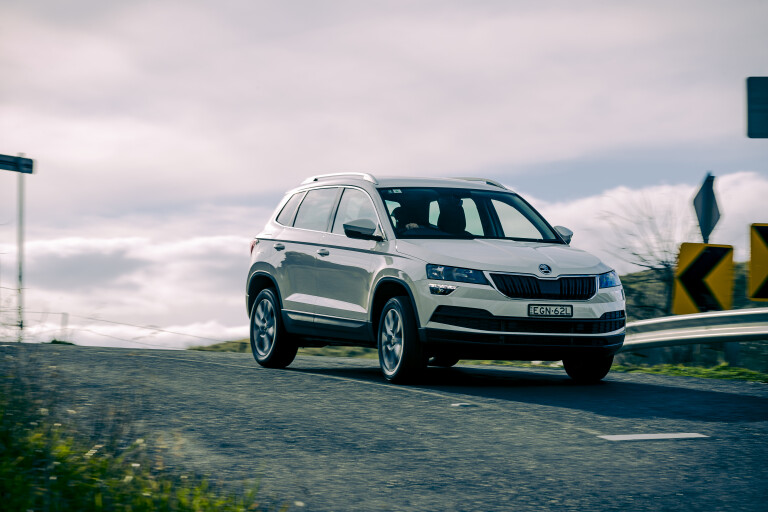
Since then, the automatic 110TSI Style’s price has also climbed from $32,990 before on-roads to $34,590. That represents a $1600 increase and prices the Style within $90 of the Tucson for this test.
The Style is light on safety technology, with rear-cross traffic alert, blind-spot warning and lane-keeping assist missing from its standard equipment list. But it still features adaptive cruise control, AEB and a rear-view camera. The Karoq also scores wireless smartphone mirroring, an 8.0-inch touchscreen, eight-speaker audio, dual-zone climate control, auto wipers, leather steering, keyless start and a gorgeous digital instrument cluster. But it misses out on power-folding mirrors that the Tucson and CR-V have and only offers one USB port upfront.
Standing back to drink in our comparison’s trio from the kerbside reveals they’re decent-looking chunks of metal, with their own quirks. The Hyundai, for instance, is the most provoking, channelling the character of an urban assault vehicle. Aggressive character lines chisel out pumped haunches. The LED daytime running lights integrated into the front grille frame also emphasise its width.

And because we treasure snag-laden barbies at Bunnings so dearly in this country, the Tucson comes to Australia in the larger, long-wheelbase format, stretching the new model’s striking design over a 2755mm gap between its axles (up from the short-wheelbase car’s 2680mm). At 4630mm long, 1865mm wide and 1665mm tall, the Tucson looks like it takes up more of the road than the other three.
However, the Honda CR-V is similarly sized to the Tucson and even pips it on length, respectively measuring 4635mm long and 1855mm wide. Because it’s built to seat seven, the extra headroom up back also means it’s taller than the Tucson (at 1679mm), lending it a more sprog-friendly look. Styling tweaks added in 2020 also frame the CR-V’s front bumper with a new chrome insert, enlarge the front radiator grille’s black element and add LED daytime running lights. Out back, the CR-V also scored a redesigned bumper insert with trapezoidal exhaust tips that looks more harmonious with the rest of the rear-end.
Curiously, the Karoq has eluded a design refresh despite internationally debuting in 2017 like the CR-V. But we’d believe Skoda if it said it didn’t need one. Its smaller front grille and discreet LED daytime running lights are complemented by pronounced silver roof rails that are adventurous yet restrained.

The Skoda Karoq leans on the resolved looks of its larger stablemate, the seven-seat Kodiaq, to disguise its small size. Built on Volkswagen’s MQB platform, the Karoq’s body measures 4382mm long (253mm shorter than the CR-V), 1841mm wide (-15mm) and 1603mm tall (-76mm). Meanwhile, its 2638mm wheelbase is also 22mm shorter than the CR-V’s.
When it comes to stuffing their bodyshells with cargo, Hyundai did well with the new Tucson. The rear hatch opens to a floor level with the rear seats when they’re flat, increasing cargo space from 539L to 1860L. While the rear seats are upright, they can also recline for passengers, who are treated to ample room in the Tucson second row.
Naturally, as this comparison’s runt, space is compromised in the Karoq. That’s why the rear seats recline 13 degrees and slide forward 150mm as part of their Varioflex design, boosting cargo volume from 479L and 588L – you decide on how much luggage you’re allowed. But it’s versatile.
Although the Karoq lacks pull levers to drop the rear seats, the second row can split in a 40/20/40 ratio, versus the Tucson’s and CR-V’s 60/40. Once the seats are flattened, you can stuff 1650L worth of cargo into the Karoq’s boot. If you need even more space, you can stand the rear seats upright or even remove each seat completely, which can boost storage capacity to 1810L.
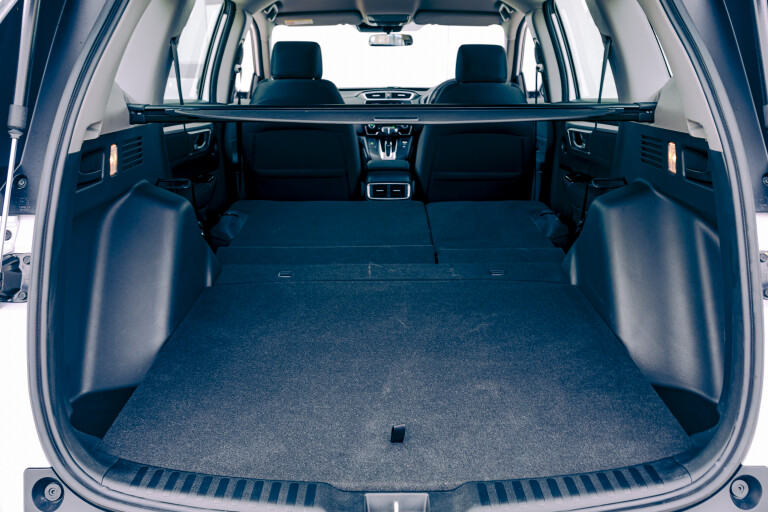
The sunken boot floor makes load access trickier, but luggage nets and hooks on either side, as well as three compartments for smaller items, make securing a range of loose items easy. Unsurprisingly, legroom in the Karoq’s second row is cramped, but you score the same amount of door storage as the CR-V, as well as a full-size armrest with cupholders like the Tucson.
Outright boot capacity in the CR-V is slightly worse off, offering 522L with the rear seats up and 1717L (113L less than the Tucson) when down. Rear access, however, is commendable, with its floor levelling with the tailgate’s lip and folded rear seats. Life in the CR-V’s second row lacks the Tucson’s legroom, but headroom is cavernous, and passengers enjoy more door storage.
But what about life up front of the cabin? Hyundai presents a smart-looking workstation that’s intuitively laid out. Thankfully, a T-shaped gear lever sits in place of the gear-selector pad saved for higher trim Elite versions, which is much tricker to operate. Meanwhile, classy looking buttons in the steering wheel and knurled column stalks lift the ambience. And while the dash sits strangely high on its left side, overall forward vision benefits from narrow front pillars. The seats have cosseting wide backrests but lack under-thigh support when set low.

When switching to the CR-V, firm seat cushions and synthetic steering wheel material underscore a slightly blander cabin ambience. But it excels on fundamentals. Outward vision is above average, benefitting from a low-set bonnet that reveals more of the road immediately in front. Ergonomics, too, are excellent. Placing the gearstick on the console, for example, means it avoids stored drink bottles altogether. The temperature and volume dials are also close to the steering wheel.
Climbing aboard the Karoq, however, feels like an upgrade to Gold Class. The cabin’s soft-touch dash plastics and perforated leather steering wheel are luxurious, and the cockpit’s layout – with HVAC dials, infotainment and driving controls contained to separate areas – is neatly structured. The Karoq’s dash sits quite high, but outward vision is adequate. The nicely bolstered front seats are comfy, even if slightly small.
But enough poking around, how do they drive? The Tucson is hamstrung with the widest turning circle of this lot (11.3m plays the CR-V’s 11m and Skoda’s 10.9m), but its light kerb weight and sharp front-end make it enjoyable to hustle, whether it be through traffic or corners. The Tucson also delivers meaningful feedback through its creamily weighted steering.

Performance-wise, you need to wring the 2.0-litre’s neck to get the best out of it. Hyundai claims the Tucson’s multi-point Smartstream G engine is new, but it shares the previous generation’s 2.0-litre bore/stroke dimensions and produces less power and torque. Still, its pep arrives up high, with 192Nm available at 4500rpm and 115kW at 6200rpm (down 7kW/13Nm). Compounding this issue is an auto that constantly upshifts on part throttle to suppress thirst – even in Sport mode.
Refinement levels are good at highway speeds but pinning the Tucson’s throttle unleashes a thrashy din that only increases in volume as it nears the 6500rpm redline. Additionally, the Tucson’s damping is firm, and the ride struggles to settle over choppy surfaces.
First impressions of the Honda CR-V behind the wheel, meanwhile, can be misleading. The steering initially can feel heavy just off-centre. But the longer you drive the CR-V, you’ll learn it steers sweetly with good accuracy and, despite weighing the most, is incredibly manoeuvrable – even if the ride lacks long-stroke absorbency.
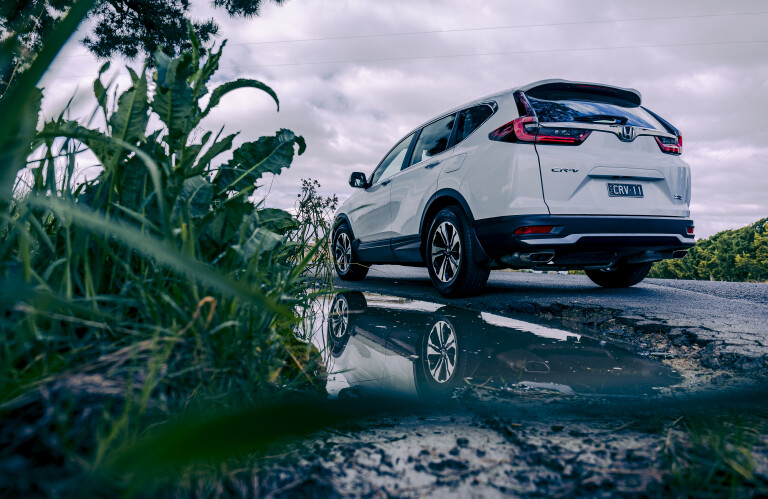
Driven hard, there are times the CR-V’s 1.5-litre turbocharged four, with 140kW and its grunty midrange delivering 240Nm from as low as 2000rpm, can surprise the front-drive layout, breaking traction at the front wheels. But this also equals quick progress while moving and part-throttle responsiveness in traffic.
Like the Tucson, the CR-V’s engine doesn’t sound great at high revs, and the CVT has a way of prolonging a slight drone under acceleration when simulating long gear ratios. The throttle can also be touchy. But otherwise, the drive experience is pleasant enough.
Refinement, though, is very much the Karoq’s domain. Its soft, long-stroke suspension deliver a cushioned ride on front struts that pair with a torsion-beam rear. But this also equals more bodyroll than its peers during hard cornering, a situation exaggerated by grippier Michelin Primacy 3 tyres.
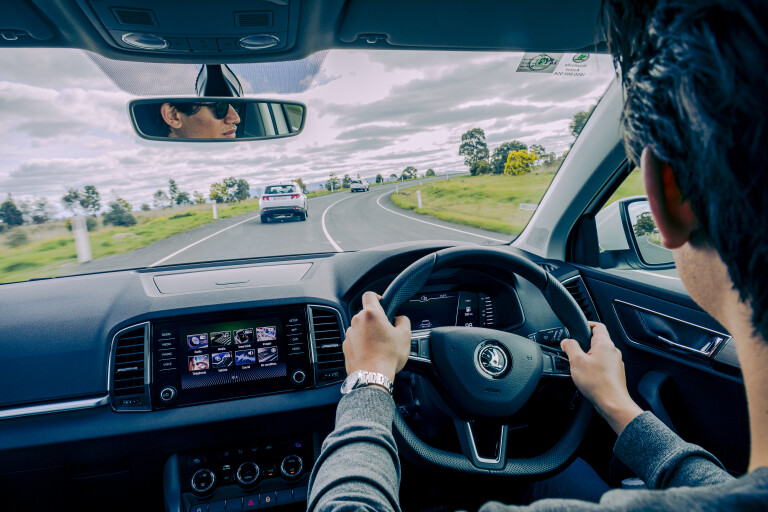
However, because of the grip, the Karoq’s road-holding ability is unshakable, while its steering is accurate and light just off-centre, making it an inspiring car to hustle. It isolates road and tyre noise especially well – a fact helped by the Karoq’s tyres being the narrowest and lowest in profile. But it takes a while to adjust to the throttle pedal’s springiness.
As for overtaking response, even though the Karoq’s new powertrain might be handicapped by a greater number of gears, the eight-speed transmission pairs well with the amply endowed 1.4-litre turbo four, handling its 110kW/250Nm outputs (carried over from the 1.5) with smooth, obedient shifts.
The Karoq does a good job keeping its engine on the boil, which delivers its peak torque not far above idle speed, from 1500rpm to 4000rpm. Smooth take-offs and positive throttle tip-in at low engine speed also bolster the Karoq’s day-to-day liveability.

Ranking our trio is not an easy task. Each medium SUV fights hard for your $35K. And unless you’re picky about cabin appearance and everyday luxury, the Karoq doesn’t get a look into the equation until driving becomes a topic.
Its softly sprung chassis and eager powertrain deliver the most well-rounded driving experience, exposing the sharp-handling Tucson as terse riding and the powerful CR-V as slightly inert. There’s a lot to like about the Skoda when you also consider its handsome design. But, ultimately, in a family-friendly category, it’s hard to overlook its light active safety equipment list and undersized packaging.
So, while the CR-V seems like a no brainer given its strong focus on day-to-day practicality, the Tucson pips it for overall cabin comfort and space – thanks to its longer wheelbase and more accommodating seats.
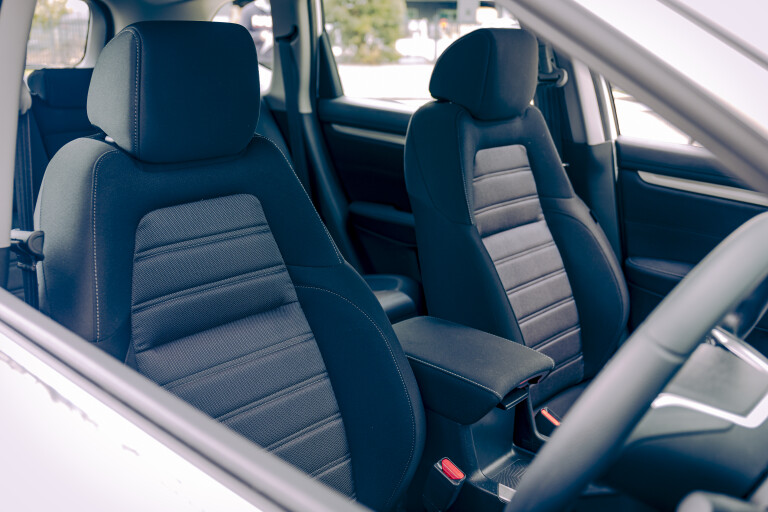
Of course, the CR-V feels stronger underfoot, with its gutsy powertrain making a strong case for downsized turbocharging, as well as CVTs – it trumps the Tucson’s six-speed powertrain for urban driveability. But the Tucson fights back with longer duration between services and a more resolved cabin.
Ultimately, yes, the Tucson cannot match the CR-V’s superior ergonomics or outward vision, but it’s the clear pick when you want as much active safety as possible protecting your family. And in the end, it steals the gong by the smallest of margins in a hard-fought contest.
But there’s no obvious loser here, each contestant offers something meaningful to their respective buyer. Let’s just hope next time we can broaden the scope of competition to give us Melburnians something really to get excited over.
SCORING
Hyundai Tucson: 7.5/10
Skoda Karoq: 7/10
Honda CR-V: 7/10
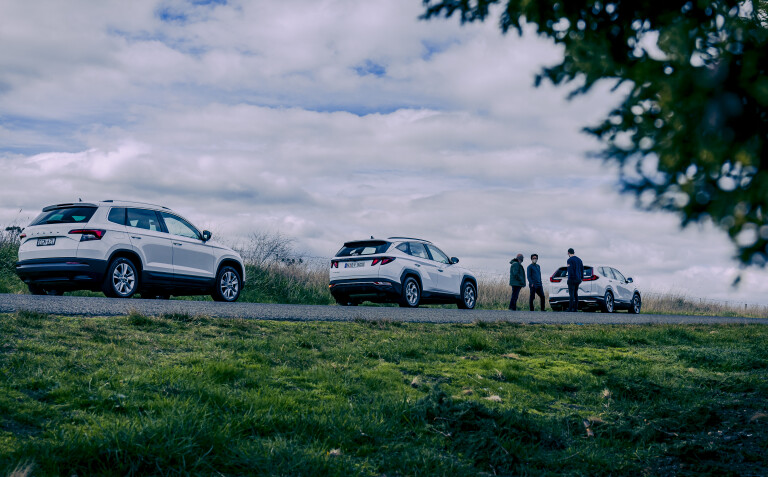
Specifications
| Hyundai Tucson | Skoda Karoq 110TSI Style | Honda CR-V VTi | |
|---|---|---|---|
| $34,500/ Tested $34,500 | $34,590/Tested $34,590 | $38,300 (DA, as tested) | |
| Drivetrain | |||
| Engine | 4cyl, dohc, 16v | 4cyl, dohc, 16v, turbo | 4cyl, dohc, 16v, turbo |
| Layout | front engine (east-west) FWD | front engine (east-west) FWD | front engine (east-west) FWD |
| Capacity | 1999cc | 1395cc | 1498cc |
| Power | 115kW @ 6200rpm | 110kW @ 5000-6000rpm | 140kW @ 5600rpm |
| Torque | 192Nm @ 4500rpm | 250Nm @ 1500-4000rpm | 243Nm @ 2000-5000rpm |
| Gearbox | 6-speed automatic | 8-speed automatic | CVT |
| Chassis | |||
| Body | steel, 5 doors, 5 seats | steel, 5 doors, 5 seats | steel, 5 doors, 5 seats |
| L/W/H/W–B | 4630/1865/1665/2755mm | 4382/1841/1603/2638mm | 4635/1855/1679/2660mm |
| Track (F/R) | 1620/1627mm | 1576/1541mm | 1601/1617mm |
| Weight | 1428kg | 1425kg | 1596kg |
| Boot | 539L | 488L | 522L |
| Fuel/tank | petrol/54 litres | petrol/50 litres | petrol/57 litres |
| Economy | 8.4L/100km (as tested) | 8.6L/100km (as tested) | 8.2L/100km (as tested) |
| Suspension | Front: struts, A-arms, anti-roll bar. Rear: multi-links, coil springs, anti-roll bar | Front: struts, A-arms, anti-roll bar. Rear: torsion beam, coil springs, anti-roll bar | Front: struts, A-arms, anti-roll bar. Rear: multi-links, coil springs, anti-roll bar |
| Steering | electric rack-and-pinion | electric rack-and-pinion | electric rack-and-pinion |
| Front brakes | 305mm ventilated discs | 312mm ventilated discs | 315mm ventilated discs |
| Rear brakes | 300mm solid discs | 272mm solid discs | 310mm solid discs |
| Tyres | Nexen Roadian GTX | Michelin Primacy 3 | Dunlop SP Sport Maxx 050 |
| Tyre size | 235/65 R17 | 215/55 R17 | 235/65 R17 |
| Safety | |||
| ANCAP rating | 5 stars (2021) | 5 stars (2017) | 5 stars (2017) |
| Warranty: 5yr/unlimited km Service interval: 12 months/15,000km Glass’s 3-year resale: NA AAMI insurance: $816 | Warranty: 5yr/unlimited km Service interval: 12 months/15,000km Glass’s 3-year resale: NA AAMI insurance: $930 | Warranty: 5yr/unlimited km Service interval: 12 months/10,000km Glass’s 3-year resale: NA AAMI insurance: $1172 |

COMMENTS